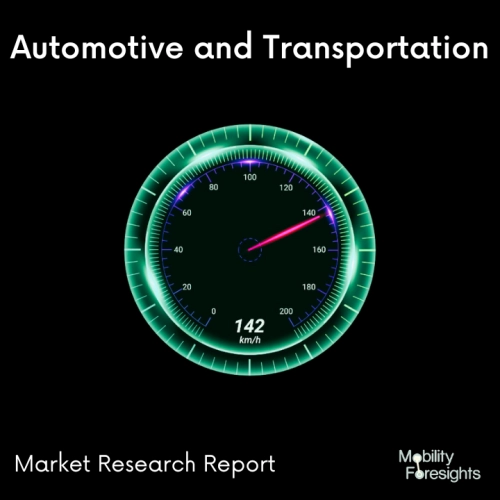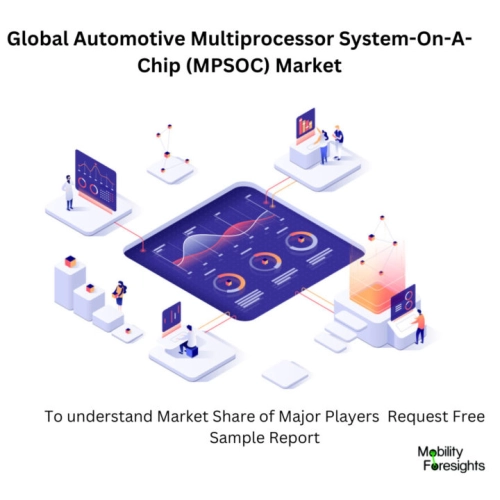
- Get in Touch with Us

Last Updated: Apr 25, 2025 | Study Period: 2023-2030
A specialized integrated circuit (IC) created specifically for use in automotive applications is referred to as an Automotive Multiprocessor System-on-a-Chip (MPSoC). It combines a number of CPU cores, a number of peripherals, and frequently has capabilities that are tailored specifically for use in automobiles.
Advanced automotive systems including infotainment systems, advanced driver assistance systems (ADAS), and autonomous driving platforms are all powered by MPSoCs.
An Automotive MPSoC's primary function is to offer high-performance computing and real-time processing for automotive applications. It makes it possible to combine many functions onto a single chip, lowering system complexity and increasing efficiency.
An MPSoC may handle numerous operations at once by having multiple processing cores, each of which is optimized for a particular job, improving the overall performance of the automobile system.
The following are some essential characteristics and parts generally included in an automotive MPSoC:
MPSoCs typically have multiple processor cores, including general-purpose cores (like ARM Cortex-A cores) for running operating systems and high-level applications and specialized cores (like ARM Cortex-R or Cortex-M cores) for real-time tasks, safety-critical operations, and control functions.
Peripherals: MPSoCs incorporate a variety of peripherals needed for automotive applications, such as display controllers, memory controllers, multimedia interfaces, sensor interfaces, and more. These include communication interfaces (CAN, LIN, Ethernet, etc.), sensor interfaces, display controllers, and memory controllers.
Automotive MPSoCs frequently contain hardware accelerators and safety procedures to assure functioning safety and security. These characteristics aid in meeting the exacting safety standards of automotive systems, such as functional safety compliance with ISO 26262.

The Global Automotive Multiprocessor System-On-A-Chip (Mpsoc) Market accounted for $XX Billion in 2022 and is anticipated to reach $XX Billion by 2030, registering a CAGR of XX% from 2023 to 2030.
A high-tech semiconductor with the entire system on a single chip.
It is a method where a system made up of many devices with various functionalities is combined into a single chip. One chip contains the computational component (CPU), memory component (DRAM, flash, etc.), digital signal processor (DSP), and more key semiconductor components, making the chip a self-contained system.
In other words, it is a process where several semiconductor chips from the PCB (Printed Circuit Board) are collected and combined into a single chip.
The area that semiconductors take up is reduced when they are combined onto a single chip, enabling the miniaturization of devices. Other advantages include lower production costs compared to producing multiple.
MPSoC INTERCONNECT: A point-to-point comprehensive interconnect network links the PEs (along with the RISC-interface) to one another. The entire crossbar architecture interconnect network utilized in the multiprocessor array has an autonomous arbitration mechanism for concurrent requests to the same destination.
| Sl no | Topic |
| 1 | Market Segmentation |
| 2 | Scope of the report |
| 3 | Abbreviations |
| 4 | Research Methodology |
| 5 | Executive Summary |
| 6 | Introduction |
| 7 | Insights from Industry stakeholders |
| 8 | Cost breakdown of Product by sub-components and average profit margin |
| 9 | Disruptive innovation in the Industry |
| 10 | Technology trends in the Industry |
| 11 | Consumer trends in the industry |
| 12 | Recent Production Milestones |
| 13 | Component Manufacturing in US, EU and China |
| 14 | COVID-19 impact on overall market |
| 15 | COVID-19 impact on Production of components |
| 16 | COVID-19 impact on Point of sale |
| 17 | Market Segmentation, Dynamics and Forecast by Geography, 2023-2030 |
| 18 | Market Segmentation, Dynamics and Forecast by Product Type, 2023-2030 |
| 19 | Market Segmentation, Dynamics and Forecast by Application, 2023-2030 |
| 20 | Market Segmentation, Dynamics and Forecast by End use, 2023-2030 |
| 21 | Product installation rate by OEM, 2023 |
| 22 | Incline/Decline in Average B-2-B selling price in past 5 years |
| 23 | Competition from substitute products |
| 24 | Gross margin and average profitability of suppliers |
| 25 | New product development in past 12 months |
| 26 | M&A in past 12 months |
| 27 | Growth strategy of leading players |
| 28 | Market share of vendors, 2023 |
| 29 | Company Profiles |
| 30 | Unmet needs and opportunity for new suppliers |
| 31 | Conclusion |
| 32 | Appendix |